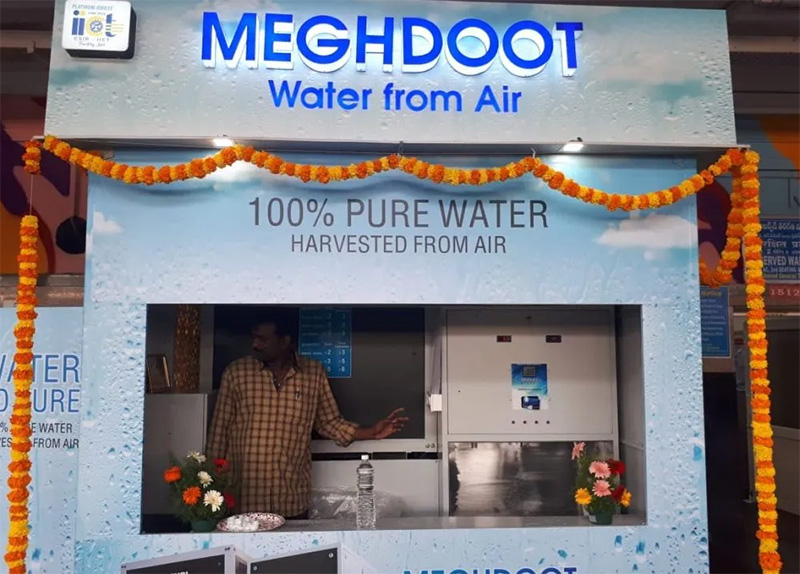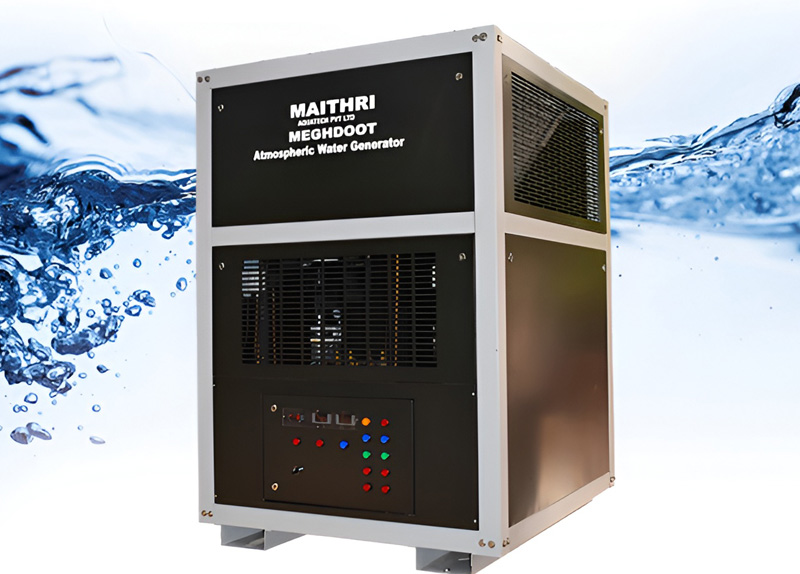Atmospheric Water Generators are systems that extract water from moisture present in the air. They work on the principle of condensation — cooling humid air to collect water droplets — which are then filtered, mineralized, and made fit for human consumption.

Bihar, a state richly endowed with rivers and monsoon rainfall, paradoxically faces frequent water stress. From urban centres like Patna grappling with erratic supply and groundwater depletion, to rural districts facing seasonal scarcity or contamination, access to safe and reliable drinking water remains a persistent challenge. As climate change intensifies water unpredictability, there is a growing need for innovative, decentralized solutions that work across geographies — and one such solution is Atmospheric Water Generation (AWG).
Atmospheric Water Generators (AWGs) are systems that extract water from moisture present in the air. They work on the principle of condensation — cooling humid air to collect water droplets — which are then filtered, mineralized, and made fit for human consumption.
This is not science fiction. Just as a cold surface forms dew, these systems condense atmospheric humidity to create potable water — without needing groundwater, pipelines, or tankers. AWGs are already being deployed in multiple states across India and hold immense relevance for Bihar.
Despite a strong groundwater base, many districts in Bihar suffer from poor water quality. Fluoride, iron, arsenic, and microbial contamination are widespread, particularly in the Gangetic belt and flood-prone regions. In several towns and villages, especially during summer or post-flood seasons, access to clean and safe drinking water becomes extremely difficult.
Additionally, power outages, infrastructure gaps, and urban-rural disparities in water supply continue to hinder the success of piped water schemes. AWG technology offers a parallel, decentralized solution that can address these challenges in a sustainable way.
1. Schools and Anganwadis: In rural areas and tribal belts, AWGs can provide reliable, clean drinking water for children without the need for tankers or borewells.
2. Primary Health Centres and Hospitals: Medical facilities, especially in flood-affected or remote regions, require clean water for both drinking and sanitation. AWGs can ensure uninterrupted, on-site water availability.
3. Railway Stations, Bus Terminals, and Government Offices: High footfall areas can benefit from AWG-based water kiosks, reducing dependence on bottled water or tanker supply.
4. Flood Relief Camps and Emergency Response: Bihar, being flood-prone, can benefit greatly from mobile or rapidly deployable AWGs to ensure potable water during natural disasters.
5. Panchayat Bhawans and Community Centres: Local governments can install AWGs as demonstration units, promoting public access and awareness.
AWGs are modular, require minimal civil work, and can be powered by solar or hybrid power sources. They produce water that is already distilled and then mineralized, often exceeding the quality parameters prescribed by the Bureau of Indian Standards (BIS) for potable water. With no chemical additives and zero discharge, they are environmentally safe.
In Bihar’s humidity-rich climate, the efficiency of AWGs is naturally high. Moreover, when evaluated over the lifecycle – including avoided costs of logistics, borewell digging, and disease treatment – AWGs are increasingly cost-effective. The Ministry of Jal Shakti, Government of India, has recognized AWG technology as a viable decentralized water solution.
Maithri Aquatech, the Indian Original Equipment manufacturers of Meghdoot AWGs, has their AWG technology formally approved by the Ministry of Jal Shakti. While many private and public organizations have adopted their systems across the country, the opportunity to leverage this innovation in Bihar remains largely untapped.


For Bihar to adopt AWG at scale, state and district administrations can:
- Include AWG technology in District Water Security Plans and Jal Jeevan Mission strategies, especially for quality-affected areas.
- Promote AWGs in smart city projects, urban local body offices, and new public buildings.
- Facilitate pilot installations in rural blocks with poor groundwater quality.
- Provide capital subsidies or policy incentives for deployment in flood-prone and drought-prone areas.
Like all technologies, AWGs face certain constraints:
- Energy Consumption: While modern systems are highly efficient and solar-compatible, electricity availability must be ensured for uninterrupted function.
- Initial Cost: Capital expenditure can be higher than traditional water sources, though operating costs remain low and stable.
- Awareness: Local officials, engineers, and planners may need orientation on the suitability and deployment models of AWGs.
However, these challenges can be addressed with proactive policy support, demonstration projects, and inclusion in procurement frameworks.
Atmospheric Water Generation is not a replacement for rivers, reservoirs, or groundwater, but a smart supplement that enhances resilience, especially in areas where traditional sources fall short.
For Bihar, with its mix of floodplains, humid climate, and water quality challenges, AWGs represent a timely, practical solution that can empower communities, reduce dependence on overdrawn aquifers, and ensure safe drinking water for all.
As the state moves forward in its Jal Jeevan Mission and the Sustainable Development Goals (SDGs), it is time to explore, adopt, and lead in deploying AWG technology across public, institutional, and community spaces. With the right support, Bihar can set an example for the rest of the country in embracing atmospheric water as a reliable and sustainable resource.
